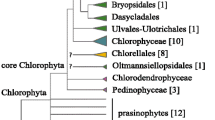Abstract
The chloroplast genome of the highly neutral-lipid-producing marine pennate diatom Fistulifera sp. strain JPCC DA0580 was fully sequenced using high-throughput pyrosequencing. The general features and gene content were compared with three other complete diatom chloroplast genomes. The chloroplast genome is 134,918 bp with an inverted repeat of 13,330 bp and is slightly larger than the other diatom chloroplast genomes due to several low gene-density regions lacking similarity to the other diatom chloroplast genomes. Protein-coding genes were nearly identical to those from Phaeodactylum tricornutum. On the other hand, we found unique sequence variations in genes of photosystem II which differ from the consensus in other diatom chloroplasts. Furthermore, five functional unknown ORFs and a putative serine recombinase gene, serC2, are located in the low gene-density regions. SerC2 was also identified in the plasmids of another pennate diatom, Cylindrotheca fusiformis, and in the plastid genome of the diatom endosymbiont of Kryptoperidinium foliaceum. Exogenous plasmids might have been incorporated into the chloroplast genome of Fistulifera sp. by lateral gene transfer. Chloroplast genome sequencing analysis of this novel diatom provides many important insights into diatom evolution.


Similar content being viewed by others
References
Ansorge WJ (2009) Next-generation DNA sequencing techniques. New Biotechnol 25(4):195–203
Argueso JL et al (2009) Genome structure of a Saccharomyces cerevisiae strain widely used in bioethanol production. Genome Res 19(12):2258–2270
Armbrust EV et al (2004) The genome of the diatom Thalassiosira pseudonana: ecology, evolution, and metabolism. Science 306(5693):79–86
Bowler C et al (2008) The Phaeodactylum genome reveals the evolutionary history of diatom genomes. Nature 456(7219):239–244
Camacho C, Coulouris G, Avagyan V, Ma N, Papadopoulos J, Bealer K, Madden TL (2009) Blast+: architecture and applications. BMC Bioinformatics 10:421
Conant GC, Wolfe KH (2008) GenomeVx: simple web-based creation of editable circular chromosome maps. Bioinformatics 24(6):861–862
Courchesne NMD, Parisien A, Wang B, Lan CQ (2009) Enhancement of lipid production using biochemical, genetic and transcription factor engineering approaches. J Biotechnol 141(1–2):31–41
De La Rocha CL, Brzezinski MA, DeNiro MJ, Shemesh A (1998) Silicon-isotope composition of diatoms as an indicator of past oceanic change. Nature 395(6703):680–683
Guillard RRL (1975) Culture of phytoplankton for feeding marine invertebrates. In: Smith WL, Chanley MH (eds) Culture of marine invertebrate animals. Plenum Press, New York, pp 26–60
Hert DG, Fredlake CP, Barron AE (2008) Advantages and limitations of next-generation sequencing technologies: a comparison of electrophoresis and non-electrophoresis methods. Electrophoresis 29(23):4618–4626
Hildebrand M, Hasegawa P, Ord RW, Thorpe VS, Glass CA, Volcani BE (1992) Nucleotide sequence of diatom plasmids: Identification of open reading frames with similarity to site-specific recombinases. Plant Mol Biol 19(5):759–770
Hongoh Y, Sharma VK, Prakash T, Noda S, Taylor TD, Kudo T, Sakaki Y, Toyoda A, Hattori M, Ohkuma M (2008) Complete genome of the uncultured termite group 1 bacteria in a single host protist cell. Proc Natl Acad Sci USA 105(14):5555–5560
Imanian B, Pombert JF, Keeling PJ (2010) The complete plastid genomes of the two ‘dinotoms’ Durinskia baltica and Kryptoperidinium foliaceum. PLoS One 5(5):e10711
Kowallik KV, Stoebe B, Schaffran I, Kroth-Pancic P, Freier U (1995) The chloroplast genome of a chlorophyll a + c-containing alga, Odontella sinensis. Plant Mol Biol Rep 13(4):336–342
Lowe TM, Eddy SR (1997) tRNAscan-SE: a program for improved detection of transfer RNA genes in genomic sequence. Nucleic Acids Res 25(5):955–964
Luo H, Eaton-Rye JJ (2008) Directed mutagenesis of the transmembrane domain of the PsbL subunit of photosystem II in Synechocystis sp. PCC 6803. Photosynth Res 98(1–3):337–347
Matsumoto M, Sugiyama H, Maeda Y, Sato R, Tanaka T, Matsunaga T (2010) Marine diatom, Navicula sp. strain JPCC DA0580 and marine green alga, Chlorella sp. strain NKG400014 as potential sources for biodiesel production. Appl Biochem Biotechnol 161:483–490
Oudot-Le Secq MP, Grimwood J, Shapiro H, Armbrust EV, Bowler C, Green BR (2007) Chloroplast genomes of the diatoms Phaeodactylum tricornutum and Thalassiosira pseudonana: comparison with other plastid genomes of the red lineage. Mol Genet Genomics 277(4):427–439
Rodolfi L, Zittelli GC, Bassi N, Padovani G, Biondi N, Bonini G, Tredici MR (2009) Microalgae for oil: strain selection, induction of lipid synthesis and outdoor mass cultivation in a low-cost photobioreactor. Biotechnol Bioeng 102(1):100–112
Rutherford K, Parkhill J, Crook J, Horsnell T, Rice P, Rajandream MA, Barrell B (2000) Artemis: sequence visualization and annotation. Bioinformatics 16(10):944–945
Schenk PM, Thomas-Hall SR, Stephens E, Marx UC, Mussgnug JH, Posten C, Kruse O, Hankamer B (2008) Second generation biofuels: high-efficiency microalgae for biodiesel production. BioEnergy Res 1(1):20–43
Schuster SC (2008) Next-generation sequencing transforms today’s biology. Nat Methods 5(1):16–18
Tangphatsornruang S, Sangsrakru D, Chanprasert J, Uthaipaisanwong P, Yoocha T, Jomchai N, Tragoonrung S (2010) The chloroplast genome sequence of mungbean (Vigna radiata) determined by high-throughput pyrosequencing: structural organization and phylogenetic relationships. DNA Res 17(1):11–22
Acknowledgments
This work was supported by JST, CREST.
Author information
Authors and Affiliations
Corresponding author
Electronic supplementary material
Below is the link to the electronic supplementary material.
Supplementary Table S-1
Comparative analysis of basal gene expression apparatus in the chloroplast among Fistulifera sp. JPCC DA0580 and other chromalveolates (XLSX 16 kb)
Supplementary Table S-2
Comparative analysis of basal photosynthetic apparatus in the chloroplast among Fistulifera sp. JPCC DA0580 and other chromalveolates (XLSX 18 kb)
Supplementary Table S-3
Photosynthetic component including distinctive divergence of Fistulifera sp. JPCC DA0580 among plastids derived from diatoms (XLSX 16 kb)
Rights and permissions
About this article
Cite this article
Tanaka, T., Fukuda, Y., Yoshino, T. et al. High-throughput pyrosequencing of the chloroplast genome of a highly neutral-lipid-producing marine pennate diatom, Fistulifera sp. strain JPCC DA0580. Photosynth Res 109, 223–229 (2011). https://doi.org/10.1007/s11120-011-9622-8
Received:
Accepted:
Published:
Issue Date:
DOI: https://doi.org/10.1007/s11120-011-9622-8




